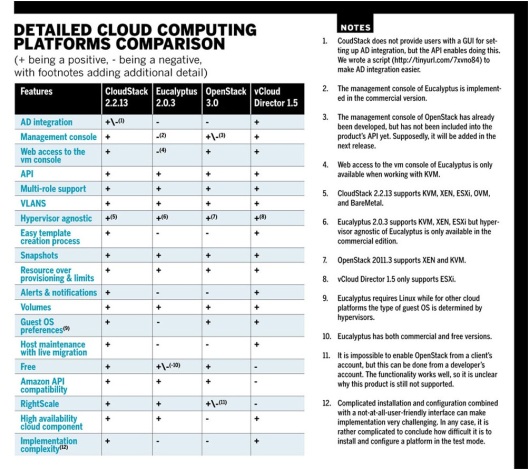Recently I’ve received an e-mail about this post
titled “Open IaaS Platform Comparison (2nd part)” from Mr. Marten
Mickos, CEO of Eucalyptus Systems, clarifying or amending some
of my comments that I should publish. I quote its words:
Comments from Eucalyptus:
- We agree that the API abstractions of Amazon Web Services have become a de facto standard in the cloud world. More than that, the AWS ecosystem is the most important driving force in software development for cloud today.
- Eucalyptus has the most complete AWS compatibility and is the only vendor to work in partnership with Amazon Web Services on API compatibility.
- Eucalyptus has a range of advanced storage services including Walrus (compatible with S3), EBS and JBOD.
- The Network World comparison is radically outdated and partly incorrect.
- It is based on Eucalyptus 2.0 which was shipped in 2010. Since then, Eucalyptus has gone through three major product generations – 3.0, 3.1 and now 3.2. – and added significant functionality such as HA, IAM, a new user console, etc.
- Generally, Eucalyptus stands out in a comparison with the other 3 open source cloud platforms as the one that is AWS API compatible and the one that has taken productization the farthest. Therefore, it is the fastest path to a functioning hybrid cloud.
And my own comments about Eucalyptus
clarifications or amendments are:
- I’ve let out OpenNebula in this second part of comparison (but not in the first one, referred also in the blog) only because I use (that I clearly stated that it was copied from “Network World”) a table done by other (I mentioned Mr. Vadim Truksha) that unfortunately does not include OpenNebula.
- The same reason was the cause for referring Eucalyptus 2.0.3 and no to the current version. Actually I noted in the posted that the comparison table was done 7 months ago roughly.
- About some of their words about AWS I fully agree too. In fact in my aforesaid post I argue the same ideas but in other words:
- AWS – holds 70 percent of the IaaS; by the way we should be honest and thank Amazon for popularizing IaaS and making it affordable, accessible, and broadly relevant to the current IT market, and for keep innovating about.
- AWS APIs are becoming, in some way, a “de facto” standard since other vendors declare to be compatible with.
- Besides, I also said that Eucalyptus signed an agreement with Amazon in 2012, that it also made it easier for Eucalyptus to bill their product as the natural partner to Amazon’s offerings
Of course, I’ve not doubts about Mr. Mickos corrections about Eucalyptus’
product, so I beg its pardon about the possible inconvenient and I’m publishing
this note in different ways and media to solve the problem.
Finally I want to thanks Mr. Mickos a lot for spending its time reading my
blog and sending its clarifying words, given me the opportunity of correcting
and improving my blog.
